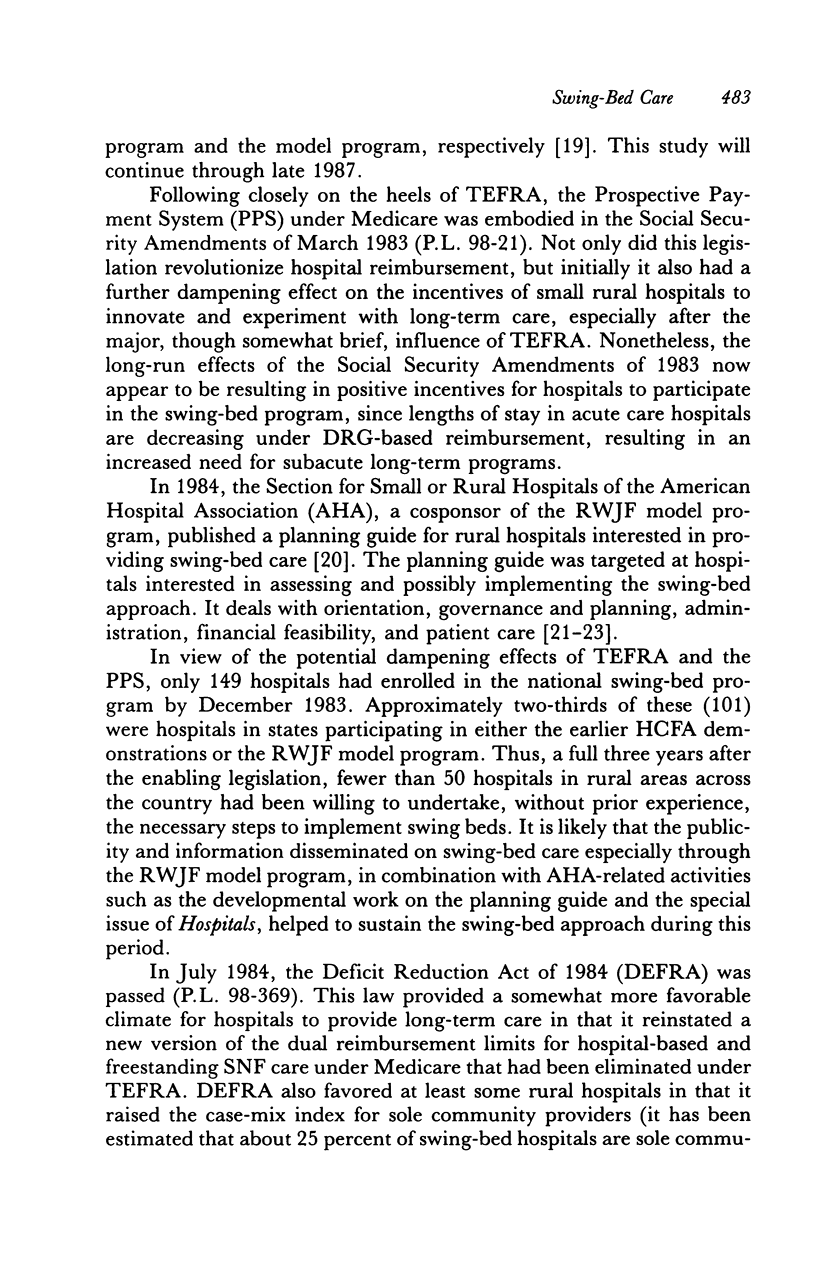Abstract
As a result of federal legislation implemented in 1982, hospital beds that are used to provide both long-term care and acute care are now proliferating rapidly throughout the country. Termed swing beds, such beds are currently restricted to rural areas. However, due largely to the impacts of Medicare DRG reimbursement, pressure is mounting to expand the swing-bed approach to urban settings. Swing beds appear to fill a significant gap between the relatively intense medical needs of post-acute care patients (now discharged earlier) and the capacity of our current nursing home delivery system to meet such needs. The evolution of swing beds is marked by an unusual blend of experimentation, scientific investigation, and public policy response to community and personal health care needs. This article summarizes that evolution, highlighting research findings and key policy developments. It concludes with the current status of the national swing-bed program and issues pertinent to future directions.
Full text
PDF





















Selected References
These references are in PubMed. This may not be the complete list of references from this article.
- Aland K. M., Walter B. A. Hospitals in Utah reduce costs, improve use of facilities. Hospitals. 1978 Mar 16;52(6):85–87. [PubMed] [Google Scholar]
- Burton R. D. Swing-bed concept in Utah . . . a decade of experience 1982. J Patient Acc Manage. 1982 Apr-May;:10–16. [PubMed] [Google Scholar]
- Hanus J. Two rural hospitals' projects apply swing bed concept successfully. Hosp Prog. 1980 May;61(5):63-5, 77. [PubMed] [Google Scholar]
- Jessee W. F. Quality assurance: evaluating services of small, swing-bed hospitals. Hospitals. 1982 Nov 16;56(22):74–77. [PubMed] [Google Scholar]
- Jones L. Survey shows growing hospital involvement in health promotion activities. Hospitals. 1982 Jun 1;56(11):88–90. [PubMed] [Google Scholar]
- Leaver W. The swing bed concept. Mich Hosp. 1980 Feb;16(2):20–22. [PubMed] [Google Scholar]
- Pennell F. Reimbursement: "carve-out' method benefits swing-bed hospitals. Hospitals. 1982 Nov 16;56(22):79-80, 83-4. [PubMed] [Google Scholar]
- Richardson H., Kovner A. R. Implementing swing-bed services in small rural hospitals. J Rural Health. 1986 Jan;2(1):46–60. doi: 10.1111/j.1748-0361.1986.tb00135.x. [DOI] [PubMed] [Google Scholar]
- Shannon K. Swing-bed program's success spurs proposals to expand eligibility. Hospitals. 1985 Mar 1;59(5):78–78. [PubMed] [Google Scholar]
- Shaughnessy P. W., Breed L. D., Landes D. P. Assessing the quality of care provided in rural swing bed hospitals. QRB Qual Rev Bull. 1982 May;8(5):12–20. [PubMed] [Google Scholar]
- Shaughnessy P. W., Kramer A. M., Schlenker R. E., Polesovsky M. B. Nursing home case-mix differences between Medicare and non-Medicare and between hospital-based and freestanding patients. Inquiry. 1985 Summer;22(2):162–177. [PubMed] [Google Scholar]
- Shaughnessy P. W., Lutz E. Nurse/physician reactions to 'swing beds'. Hosp Med Staff. 1979 Mar;8(3):10–18. [PubMed] [Google Scholar]
- Shaughnessy P. W., Schlenker R. E. Planning: implementing new swing-bed programs. Hospitals. 1982 Nov 16;56(22):86–90. [PubMed] [Google Scholar]
- Shaughnessy P. W., Tynan E. A. The use of swing beds in rural hospitals. Inquiry. 1985 Fall;22(3):303–315. [PubMed] [Google Scholar]
- Smits H. L. Incentives in case-mix measures for long-term care. Health Care Financ Rev. 1984 Winter;6(2):53–59. [PMC free article] [PubMed] [Google Scholar]
- Supplitt J. T. Swing beds: new diversification opportunity for small and rural hospitals. Hospitals. 1982 Nov 16;56(22):67-8, 70, 72. [PubMed] [Google Scholar]
- Walter B. A., West J. D., Elggren M. D. Small hospitals find swing beds profitable. Forum (Wash) 1980 Jun;4(2):16–17. [PubMed] [Google Scholar]


